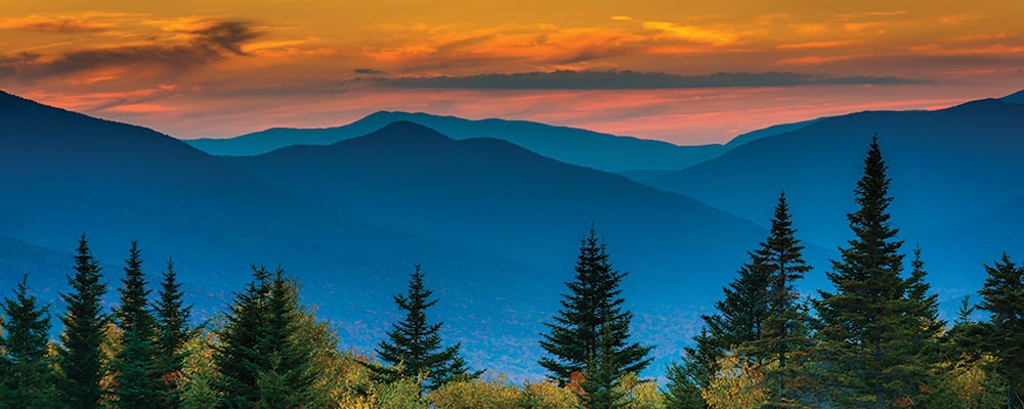Explore the highlights from 75 years of conservation and Exemplary Forestry, and then see what’s next for NEFF.
1860-1940: A Period of Rapid Change for Forests and Conservation
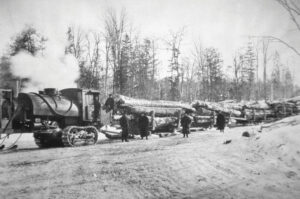
In the early 1900s, inventive new technology like the pictured Lombard logging vehicle allowed for an increase in exploitative harvesting at a time when forests were already vulnerable. NEFF’s founders would go on to advocate for the responsible use of technology in forestry.
At the time of European settlement, forests covered 90 percent or more of New England. By the mid 1880s, however, vast stretches of this landscape-defining feature had been harvested and then cleared for agriculture; Massachusetts, Connecticut and Rhode Island were hardest hit, and lost up to 70 percent of their forests. While forests began to regenerate when farming moved west, little stood between vulnerable young forests and unchecked exploitation of natural resources.
In the face of increasing pressure from concerned citizens and scientists, the United States government began to take action to protect forests in the late 1800s. Congress passed the first law establishing a park on federal forestland in 1864, and in 1911 passed the Weeks Act, which allowed the federal government to acquire forestland and create national forests like the White Mountain National Forest of 1918. The executive branch also took positive steps: The U.S. Department of Agriculture established a Division of Forestry in 1881, the first federal forest reserve was set aside in 1891, and Gifford Pinchot as head of the Division of Forestry worked with President Teddy Roosevelt to establish the U.S. Forest Service in 1905.
While these actions proved effective at protecting certain high-priority forestlands and providing forestry expertise and services to large-scale corporate and public landowners, the federal government did little to improve the management of private, individually owned forestlands until 1937, when Congress passed the Norris-Doxey Cooperative Farm Forestry Act. It funded state foresters tasked with providing management and harvesting advice to landowners; it was also deemed inadequate by experts like New England Forestry Foundation (NEFF) founder Harris Reynolds, who felt that in place of piecemeal advice, landowners needed hands-on management services and long-term support that promoted forest health.
1944: New England Forestry Foundation Steps Onto the Stage
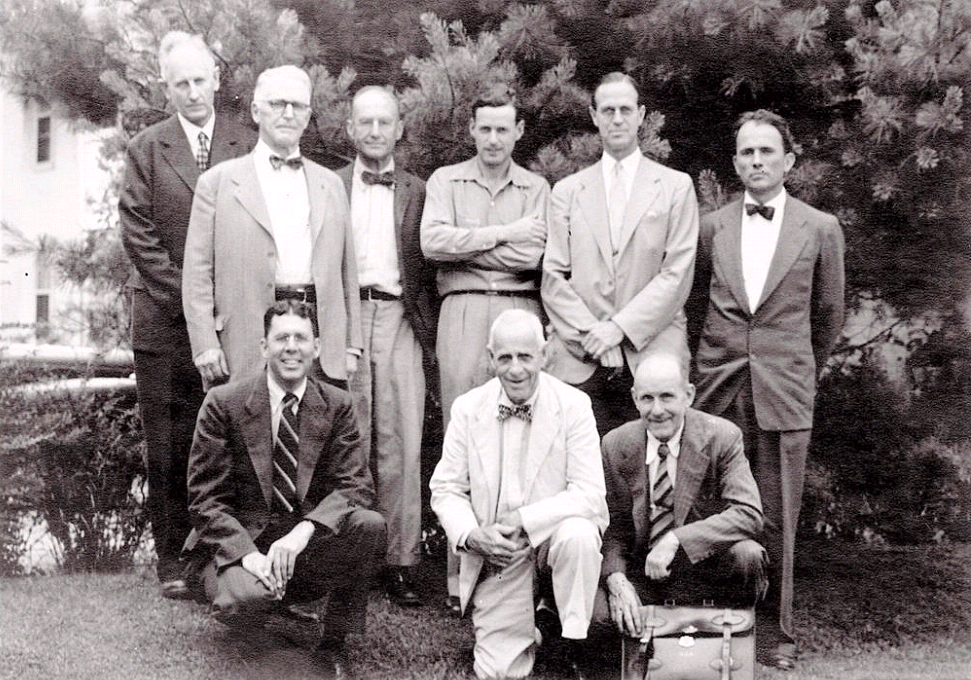
NEFF Directors meeting in New Hampshire (1945). Back row, left to right: Unknown, Hugh P. Baker, William P. Wharton, J. Milton Attridge, Nathan Tufts, James L. Madden. Front row, left to right: Farnham W. Smith, Ralph C. Hawley, Harris A. Reynolds.
Reynolds and an eclectic cohort of foresters and outdoor enthusiasts had long been concerned about clear-cutting and destructive management on private forestlands in New England, where parcel owners often acted with an eye to quick profit or simply lacked an understanding of how to care for a forest. In response to the absence of effective government services, they decided to form a region-wide charitable organization devoted to the practice, teaching and promotion of sustainable forest management, and so New England Forestry Foundation was born July 12, 1944 to help private forests thrive.
Reynolds and partners at the Massachusetts Forest and Parks Association designed a system of forest management centers for NEFF, in which trained consulting foresters would take responsibility for specific geographic regions and build relationships with local landowners.
1945: NEFF Opens Its First Forest
When NEFF’s Lincoln Davis Memorial Forest opened to the public in 1945, it not only offered local residents an easily accessible place to enjoy woodland recreation—something of a novelty at the time, as the concept of town forests was quite new in the United States—but it also served as the first step in NEFF’s Exemplary Forestry work. As a demonstration forest, it allowed NEFF foresters to practice and start developing the in-house management style that has grown into NEFF’s current Exemplary Forestry standards.
1945: Milt Attridge Joins NEFF and Helps Shape Its Forestry Program
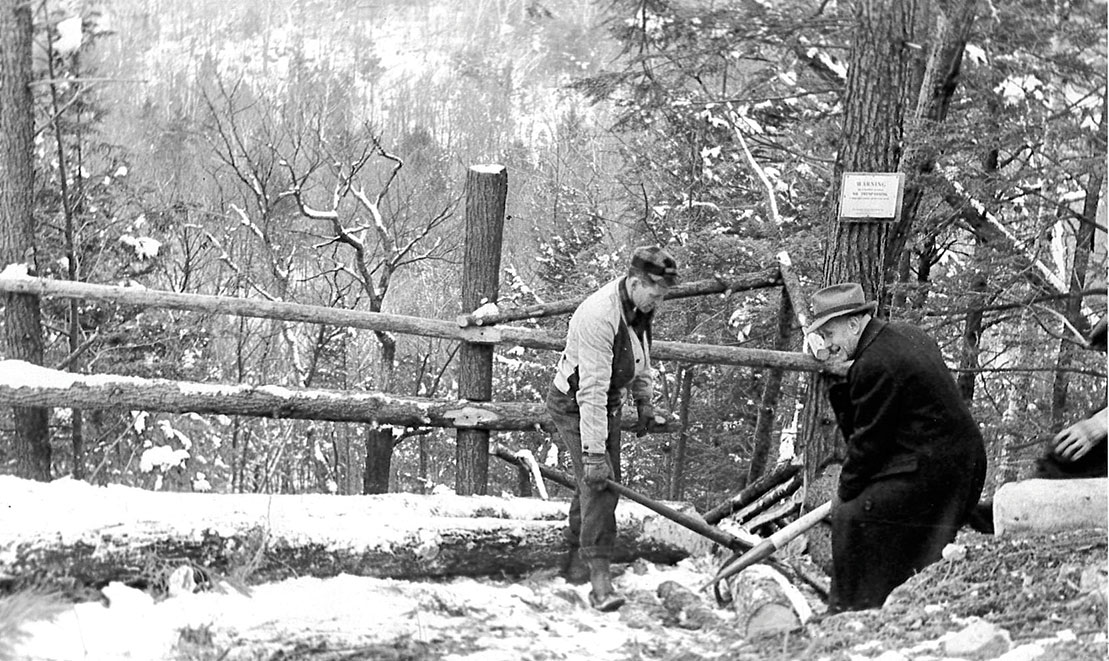
NEFF forester Milt Attridge (left) and NEFF founder Harris Reynolds start a log down a log chute to the valley below.
NEFF’s system of forest management centers really started to take shape when NEFF hired Milt Attridge, the organization’s first full-time forester and eventual Chief Forester. Attridge played a crucial role in NEFF’s early forestry work, and was well respected for his expertise and commitment to sustainability by fellow foresters and the communities in which he worked. Given his experience, Attridge was able to provide unique insight into the development of NEFF’s forestry program and its impact when interviewed for New England Forestry Foundation: A History.
Attridge on the initial pushback to New England Forestry Foundation’s approach:
“In the early years, the resistance to forest management under the Foundation came from the timber buyers, who did not understand selective cutting and were perfectly content to cut down ten small, healthy trees to get at one which they wanted to sell to the sawmill. They understand better now, and they understand our methods, and by and large accept them. It has become clear to them that they actually lose money by cutting smaller trees.”
Attridge on New England Forestry Foundation’s long-term impact:
“In more than 30 years, many lumber companies and mill operators that in 1944 would have done ruinous clear-cutting are now following conservation practices. With the equipment available today, had the bad practices of those early years continued, the very existence of our forests could well have been threatened. But thinking has kept pace with the improved equipment, with the result that the forests of today are actually in better shape than they were when the Foundation was started; and I think the Foundation should be given a good deal of the actual credit for this.”
If NEFF as a whole should be given credit for this, so too should Attridge and the teams of foresters he helped train. Learn more about Attridge in Frank Lowenstein’s “Four Foundations of the Foundation” article.
1953: NEFF Publishes a “Review of Purpose and Progress”
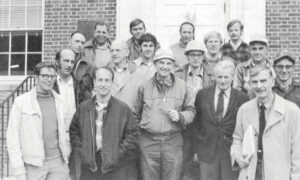
NEFF foresters visit Harvard Forest in Petersham, MA. Foreground, right: J.T. Hemenway. Front row, from left: C.B. Croft, H.T. Putnam, Sherman H. Perkins, J.M. Attridge, C.C. Richardson. Second row, from left: S. J. Rastallis, D.R. Poppema, C.M. Stewart, G.C. Knickerbocker. Third row, from left: F.A. Huntress, R.C. Boulanger, G.B. Bush. Fourth row, from left: K.E. Jones, W.A. Bean, S.B. Coville, J.C. MacMillan.
As NEFF approached its 10th anniversary, its Committee on Finance distributed a progress report in the form of an open letter to the wider NEFF community. Its charmingly forthright opening paragraph is included below, and the entire letter can be read and dowloaded as a PDF by clicking here.
“In 1943 the Massachusetts Forest and Park Association appointed a committee of woodland owners, representatives of leading forest industries and foresters to study the problems of small woodland owners. The New England Forestry Foundation is the result of that study. Started in 1944 with no money, no experience and as just an idea, it has developed in nine years into an organization with fourteen foresters in ten Management Centers, and has done work on 321,000 acres for over 1,000 owners, and has supervised the cutting of nearly 60,000,000 board feet of timber. There still remain on the lands of these clients 400,000,000 feet, worth over $7,000,000 at the average price of $17.65 obtained last year.”
The letter concludes that NEFF’s “experimental stage has been passed,” and the Committee on Finance declares the organization ready to train new foresters and expand its number of management centers. In total, NEFF would go on to hire and train 150 foresters to practice and teach sustainable management across New England.
1974: Townes Memorial Forest Opens
As NEFF’s forestry program continued to grow, so too did its network of Community Forests. The opening date of Townes Memorial Forest marks a time of transition for NEFF’s efforts to protect land through ownership—NEFF acquired about 10 forests per decade in the 1950s and 1960s, but that rate picked up significantly in the early 1970s and held through the 1980s and 1990s. NEFF took on 24 new properties in the 1970s alone, for example.
Located in New Boston, NH, the 551-acre Townes Memorial Forest is an interesting place to study glacial geology—NEFF history and the history of planet Earth, all in one spot. The property has a glacial kettle hole that was created when a large block of ice broke free of the retreating ice sheet and was later covered on all sides by outwash sands and gravels. Learn more on NEFF’s Forest Stories webpage.
1989: NEFF Launches Conservation Easement Program
As earlier portions of this timeline show, land conservation in the United States was initially conducted through ownership, either in the form of public parks and forests or private property owned by charitable organizations like NEFF. Beyond NEFF’s own work, conservation easements expanded rapidly as a favored tool for land conservation throughout the 1980s. This followed on several revisions to the federal tax code in 1976, 1977, and 1980 that established a reliable framework for tax deductions for donations of conservation easements. Progress accelerated after 1982, when the development of the Uniform Conservation Easement Act by the national Uniform Laws Commission allowed for the adoption of consistent state authorizing laws.
While NEFF accepted one easement in 1977 and another in 1980, its full program launched in 1989 when NEFF acquired a 98-acre easement in Shirley, MA. It was followed by 37 easements in the subsequent decade, and NEFF now holds 152 easements that provide protection to 1.1 million acres of forestland.
1994: The Founding of New England Forestry Consultants, Inc.
By the early 1990s, the hard work of NEFF’s founders and foresters had paid off: the profession of consulting forestry was accepted and well-established in New England. This meant it was not clear that a non-profit organization needed to continue providing forestry services directly to landowners. NEFF leadership restructured the organization, and NEFF’s consulting foresters became a new for-profit corporation that’s still hard at work in the region: New England Forestry Consultants, or NEFCo.
NEFCo and NEFF have remained close since this time of transition. NEFCo foresters manage most of NEFF’s lands, maintain NEFF’s forestry certification through the Forest Stewardship Council, and help NEFF with the design and implementation of new forestry initiatives. At this summer’s Annual Meeting, NEFCo was presented with the Forest Champion Award for exemplary efforts in forest conservation.
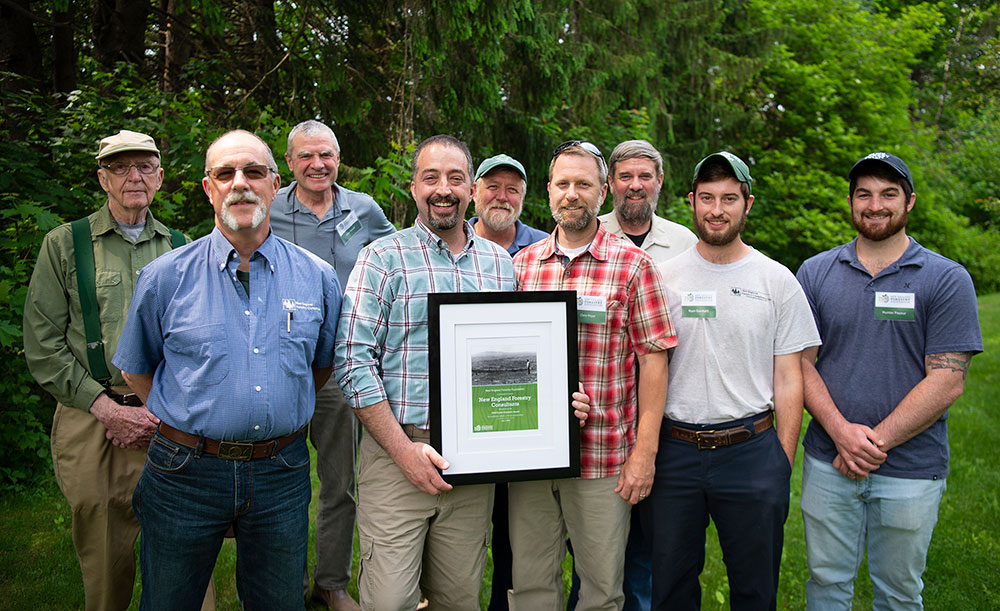
NEFCo representatives were presented with the Forest Champion Award at NEFF’s 2019 Annual Meeting. Left to right: Fred Huntress, Dennis McKenney, Peter Farrell, Shaun Lagueux, Dave Kent, NEFF Director of Forest Stewardship Chris Pryor, Sherm Small, Ryan Gumbart, Hunterr Payeur.
2001: Pingree Forest Partnership Completes Record-breaking Easement
In March 2001, NEFF and the Pingree family completed the largest forestland conservation easement in the history of the United States. The project permanently protects 762,192 acres from development.
Three and a half times the size of Baxter State Park and larger than the state of Rhode Island, the Pingree easement conserves some of the most spectacular natural resources in Maine, including the Allagash Lakes and 16 miles along the St. John River. The forests support numerous active Bald Eagle nests, 24,800 acres of managed deeryards, 72,000 acres of wetland habitat, Maine’s most productive Peregrine Falcon nesting area, and at least 67 rare and endangered plant sites. The forests were—and are—healthy and productive thanks to decades of careful stewardship by the Pingree family.
NEFF and the Pingree family’s transaction set the stage for an explosion of so-called landscape-scale conservation projects. Many of these projects pair a forest management investor with a land trust that owns a conservation easement on the property, which results in a final arrangement similar to the Pingree project.
2004: Downeast Lakes Forestry Partnership Protects Crucial Landscape
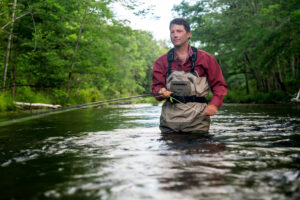
The Downeast Lakes Forestry Partnership and NEFF’s Downeast Woods and Wildlife project ensure recreational opportunities in addition to conserving land and supporting economic activity. Photo by Laurens Owens Lambert
Just a few years later, NEFF undertook a second ambitious easement project through the Downeast Lakes Forestry Partnership. This joint effort between NEFF and the Downeast Lakes Land Trust (DLLT) protected 339,000 acres in Maine’s easternmost county, and was designed to address both far-reaching conservation goals and the social and economic needs of the region.
Through this partnership, DLLT purchased and is managing 27,080 acres as the Farm Cove Community Forest, and NEFF purchased a 312,000-acre sustainable-forestry easement on the surrounding lands. Strategically situated between 600,000 acres of conservation land in New Brunswick and 200,000 acres of state, federal, and Native American lands in Maine, the project contributes to the protection of more than 1 million acres across an international boundary. Public access is granted throughout the 339,000 acres, which include more than 1,500 miles of river and stream shoreline, 445 miles of shoreline on all or portions of 60 lakes, and 54,000 acres of productive wetlands.
From local loggers to boat builders, a variety of people depend upon this largely undeveloped landscape for their livelihoods and lifestyles, and seasonal residents and visitors turn to the area for recreation and rejuvenation—all while strengthening the local economy. The area is equally important for wildlife: It’s one of the most critical Neotropical bird breeding habitats in the northern area of the Atlantic flyway, and it is home to Pine Marten, Canada Lynx, and five percent of the state’s Common Loons.
2007: Hersey Mountain Forest Declared Forever Wild
Hersey Mountain Forest is unique three times over. It’s home to NEFF’s first carbon offset project, it’s NEFF’s largest owned forest at 3,200 acres, and it’s NEFF’s first property to have a large number of acres designated as “forever wild” rather than as managed forestland. A rigorous ecological assessment of the property recommended approximately 2,100 acres for protection under a wilderness conservation easement, which was recorded in 2007 to Northeast Wilderness Trust. The assessment found more than 20 natural communities, 42 vernal pools, 68 acres of old growth forest, and 513 acres of Significant Ecological Areas. These diverse habitat types make Hersey Mountain a true haven for wildlife.
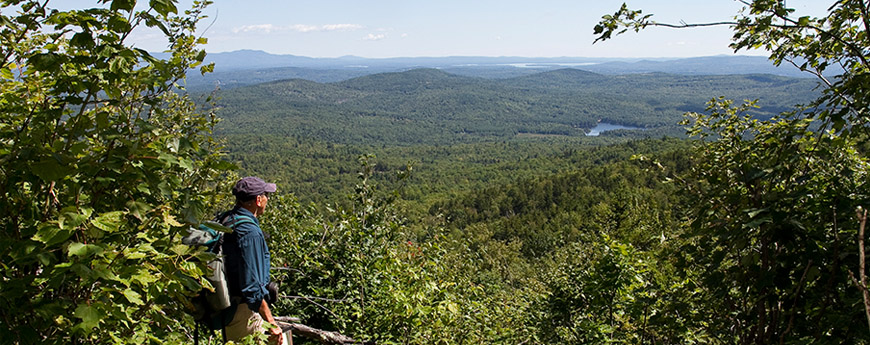
New England Forestry Foundation’s Hersey Mountain Community Forest, photo by Kari Post
2010: Regional Wildlands and Woodlands Vision Developed
Harvard Forest began developing its Wildlands and Woodlands vision in 2005, with an assessment of forest loss and the pace of conservation in Massachusetts. In 2010, the vision went region-wide, and clearly identified the need to ramp up the pace of conservation to protect forests’ benefits to New England residents. The NEFF Board of Directors formally endorsed the Wildlands and Woodlands vision in 2012, and then that same year hired a visionary forest leader to help the organization meet that mandate.
2013: NEFF Advances Mission With New Initiatives
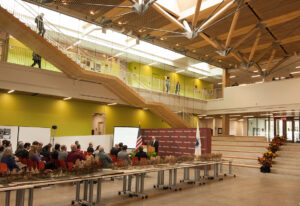
UMass Amherst’s Olver Design Building serves as a demonstration of new and innovative wood construction technologies. The building integrates a structural system consisting of exposed heavy engineered timber and cross-laminated timber decking and shear walls. Photo courtesy of University of Massachusetts, Amherst
Under the leadership of its new Executive Director, Bob Perschel, NEFF began to focus on innovative outreach, education and conservation initiatives in 2013. These initiatives furthered NEFF’s mission in new ways. First, NEFF launched its landowner outreach initiative in the MassConn Woods region to test how best to communicate with private landowners about sustainable forestry and keeping land healthy. Today, staff has sharpened messaging, improved response rates from 3 to up to 15 percent, learned how to talk with owners about climate change—and the program has now expanded to new regions. Most importantly, hundreds of previously unengaged owners have taken steps toward conservation or more active stewardship of their land.
The Build It With Wood initiative followed in 2016. This groundbreaking program promotes the construction of tall wood buildings with engineered cross-laminated timber, a sustainable material that can safely replace emissions-heavy steel and concrete. Cross-laminated timber was central to the construction of the John W. Olver Design Building at UMass Amherst, the Common Ground Charter School in New Haven, and a new dormitory at the Rhode Island School of Design. Additional mass timber buildings are planned or underway in Maine, Massachusetts, Connecticut and New York. Meanwhile, NEFF continues to promote development of a cross-laminated timber mill in New England and to document the climate benefits of building with wood.
Learn about NEFF’s other initiatives at newenglandforestry.org/learn/initiatives.
2014: NEFF Starts Preparing Exemplary Forestry Standards for Publication
NEFF has long practiced the gold standard of sustainable forestry on its own lands, and in 2014, began to codify this management style and place it into a landscape context so other landowners could make use of it. In addition to protecting forests and their ecosystem services, Exemplary Forestry is designed to accomplish three goals: improve wildlife habitat, grow more and better-quality wood, and enhance the role forests can play to mitigate climate change.
Exemplary Forestry also balances a parcel’s management with that of other nearby lands both to maximize the property’s impact and in the hopes of creating an entire landscape that meets Exemplary Forestry goals. This landscape-scale approach sets Exemplary Forestry apart from other forestry methods, just as its standards are the first to articulate the kind of forestry practices that assure climate mitigation.
NEFF has now published Exemplary Forestry standards for northern New England’s Acadian Forest region, as well as an accompanying 27-page report, “Exemplary Forestry for the 21st Century: Managing the Acadian Forest for Bird’s Feet and Board Feet at a Landscape Scale.”
2018: NEFF Heads North for Downeast Woods and Wildlife Project
In 2018, NEFF undertook an exciting shift in conservation strategy: pursuing large and select properties to protect through ownership, mostly in the region’s northern forests. Purchasing larger forestlands will allow NEFF to both address New England’s ongoing loss of forest cover and show just what Exemplary Forestry can do when practiced at scale.
NEFF’s ongoing Downeast Woods and Wildlife project is the first to follow this pattern, and it seeks to permanently protect 3,200 acres of ecologically important forestland in the wilds of Downeast Maine. The project’s impact will carry far beyond property lines, as its parcels connect to the same conserved landscape as the forests protected by the Downeast Lakes Forestry Partnership.
2019 and Beyond: What’s Next for NEFF
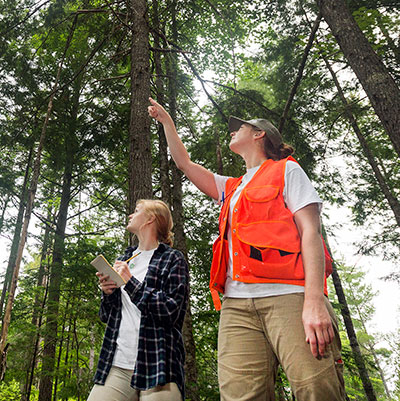
NEFF conservation staff members tour Downeast Woods and Wildlife forest parcels. Photo by Lauren Owens Lambert.
New England Forestry Foundation has experienced a successful and eventful 75 years, and with the support of its members and partners, looks forward to an even brighter future.
In the coming years, NEFF plans to:
- Advocate for the Wildlands and Woodlands vision of protecting 30 million total acres in New England.
- Conserve working forests in high-priority landscapes through easements and ownership of larger parcels.
- Help shape an economic system where cross-laminated timber made with local wood supports affordable urban housing and rural jobs in New England.
- Fight back against climate change by promoting and practicing methods to sequester carbon, build with wood, and prepare forests for the impacts of a warming world.
- Research and implement innovative ways to help private landowners protect and care for their woodlands.
- Demonstrate the value of Exemplary Forestry on NEFF’s own lands and help other landowners put its practices to work.
Join NEFF in creating a future where New England’s forests and people thrive side by side.


